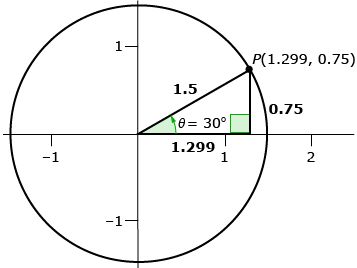Lesson 1
1. Lesson 1
1.8. Explore 4
Module 2: Trigonometry
You may be wondering how the formal definitions of primary trigonometric ratios are different from what you learned about right triangles in previous math courses. You will investigate this question in Try This 2.
Try This 2
For angles between 0° and 90°, are the formal definitions for primary trigonometric ratios based on circles different from the definitions based on triangles?
SUMMARY OF PRIMARY TRIGONOMETRIC RATIO DEFINITIONS |
|
| Ratios Based on a Circle | Ratios Based on a Triangle |
- Investigate the sine, cosine, and tangent of a 30° angle. Use the image of the triangle and Primary Trigonometric Ratios: Formal Definitions to complete a table like the following.

Trigonometric Function Trigonometric Ratio Based on a Triangle Trigonometric Ratio Based on a Circle
How do you know what length to make the circle radius?
sin 30° cos 30° tan 30° - How do the trigonometric ratios based on a circle and the ratios based on a triangle compare for sin 30°, cos 30°, and tan 30°?
- Explore this relationship further for other triangles using Relation to SOH CAH TOA. Add more rows to your table to record your observations.
- Do you think this relationship is true for other angles between 0° and 90°?
- Do you think this relationship is true for angles greater than 90°? Explain.
- Do you think this relationship is true for other angles between 0° and 90°?
![]() Save your responses in your course folder.
Save your responses in your course folder.
This triangle can also be drawn within a circle of radius 1.5. So, use a circle with a radius of 1.5.


